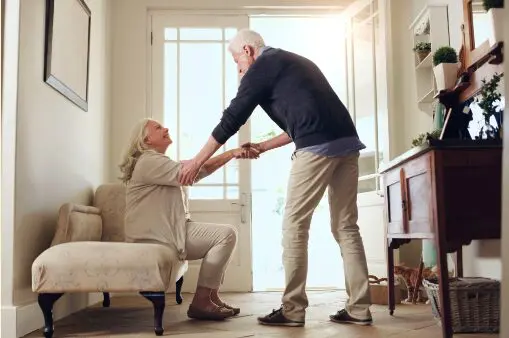For many seniors living in their own homes in Cherry Hill, the goal is clear: maintain independence, stay active, and age in place with dignity and safety. But while aging in familiar surroundings brings comfort, it also presents unique risks—especially when it comes to falls. According to national data, one in four adults aged 65 and older will fall each year, and for those who do, the consequences can include serious injuries, loss of mobility, reduced confidence and even higher medical costs.
At the same time, strategic, practical interventions can dramatically reduce those risks and help older adults continue to enjoy home life on their terms. Below is a hands-on, locally relevant guide tailored for Cherry Hill homes, offered with support from caregiving professionals who specialize in independent living.
Understanding the Risk
Aging itself brings changes that increase fall vulnerability: slower reflexes, muscle weakness, balance and vision shifts, and a higher likelihood of multiple medications. Add to that home-environment hazards—dim lighting, loose rugs, narrow hallways, slippery bathrooms—and the situation can become challenging.
Home modification, activity regulation and awareness of medication interactions have all been shown to reduce fall risk.
Because the home is often where older adults spend the majority of their time, prioritizing safety there matters. One reputable resource emphasizes that effective fall prevention for individuals at moderate to high risk involves three major levers: medication review, physical activity (balance and strength) and environmental modification.
Key Planning Points for Cherry Hill Homes
1. Conduct a Home Safety Walk-through
Start with a room-by-room check: look for loose rugs, electrical cords crossing walkways, poor lighting and uneven thresholds. Repair or remove hazards immediately. Clear furniture out of high-traffic zones. Move commonly used items to eye-level—so senior residents are not reaching up or bending down repeatedly. Install handrails where needed—on both sides of stairs, inside showers and adjacent to toilets. One home-modification guide emphasizes that simple changes—such as installing grab bars, improving lighting and removing clutter—can meaningfully reduce risk.
2. Upgrade the Lighting & Visibility
Stronger, well-placed lighting makes a big difference. Place night-lights in areas like the bedroom to bathroom path. Consider motion-sensor lights in hallways and stairwells. Ensure light switches are reachable (even when seated) and that bulbs are bright enough to show trip hazards clearly. In older homes, uneven or dark staircases are common fall triggers, so treat them as priority zones.
3. Bathroom & Stairway Safety Enhancements
Bathrooms regularly register among the highest-risk zones. Install non-slip mats, grab bars, shower chairs if needed, and consider converting a tub to a walk-in or curb-less shower for added safety. For stairs, make sure rails are sturdy, both sides if possible, and steps are uniform in height and depth. Remove any carpeting or runners that can bunch or slide. According to experts, modifications like these are among the most effective environmental interventions.
4. Encourage Strength, Balance & Activity
Physical activity remains one of the strongest defenses against falls. Activities that improve strength, balance and coordination—such as Tai Chi, walking, or balance-focused exercises—help older adults maintain stability. Simultaneously, addressing vision and hearing health matters, because sensory deficits significantly increase risk. An active lifestyle supports independence and builds confidence in everyday mobility.
5. Review Medications & Health Conditions Regularly
Medication side-effects such as dizziness or drowsiness, or health issues like arthritis, neuropathy or vision impairment, all elevate fall risk. Encourage seniors to bring a full list of medications (including over-the-counter) to each healthcare visit, and discuss whether any can be adjusted. Likewise, routine vision and hearing checks support safe navigation of the home environment.
6. Use Assistive Tools and Plan for Transitions
When mobility declines or a health event occurs, using canes, walkers or other assistive devices is not a sign of weakness—it’s a smart safety choice. Stairlifts, ramp access, and bench seats in showers are practical aids that help maintain independence longer. This proactive mindset aligns with aging-in-place goals favored by many Cherry Hill seniors.
7. Make a Safety-First Culture in the Household
For care partners (family, friends or hired caregivers), creating an environment where safety is the default helps everyone. That means helping seniors move items to reachable heights, reminding them not to rush transitions (for example moving from sitting to standing), keeping pathways clear, and being available to assist when needed. A small fall-provoking oversight—like a cord across a walkway—can be prevented with consistent habits.
8. Plan for What if a Fall Happens
Despite best efforts, falls may still occur. Having a plan helps reduce the impact. Place phones in reachable locations, consider a medical alert device for those at higher risk, and maintain an emergency contact list. After a fall, even if no serious injury appears, obtain a medical evaluation, because a single incident raises the likelihood of another.
9. Partner With Professional Support
Organizations offering in-home senior care can do more than hygiene and meals—they can help with fall-proofing the home, monitoring mobility changes, and reinforcing safe habits. Partnering with professionals early means issues are spotted before they become serious.
10. Focus on Seasonal and Maintenance Check-ups
Because homes in Cherry Hill face seasonal conditions (wet leaves, icy steps, lower daylight in winter), periodic reviews are wise. In late summer and early autumn, check exterior walkways, remove tripping hazards like leaves or bundled hoses, and ensure gutters and stairs remain safe. Inside, test lighting, check stability of railings and monitor rugs that may shift as heating systems come online.
Why This Matters in Cherry Hill
The choice to remain living in one’s own home is a meaningful one. For seniors in Cherry Hill—and their families—that choice comes with a responsibility to the environment around them. The good news: fall prevention isn’t about radical change or expensive renovations. Many of the most effective steps are low-cost and high-impact. Ensuring a home is clear, well-lit, and supportive helps maintain independence, reduces hospitalizations and supports mobility for the long haul.
At the same time, crafting a home environment that respects the aging body, integrates assistive technologies as needed, and collaborates with in-home care partners creates peace of mind for both seniors and their loved ones.
For deeper resources on senior health, wellness, independent living and home-care options across New Jersey, visit our dedicated guide at https://explorenewjersey.org/category/health-wellness/.
Embracing a proactive mindset toward fall prevention transforms a home from simply “where one lives” to “where one thrives.”











